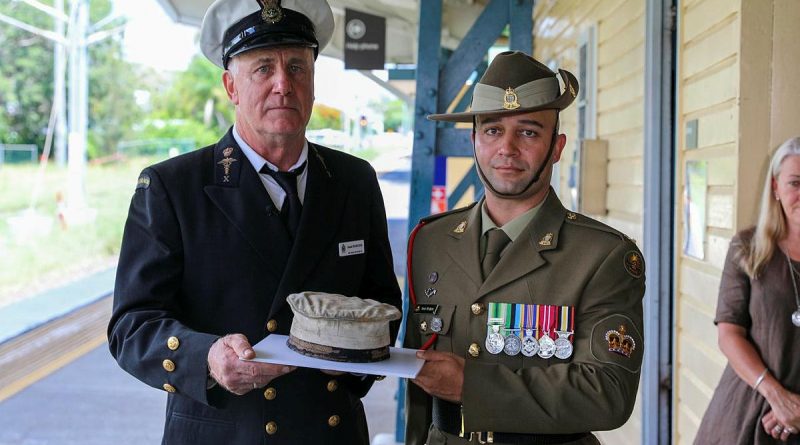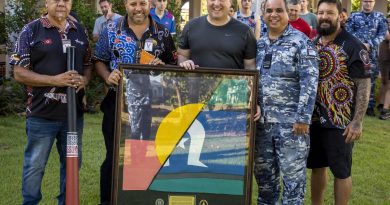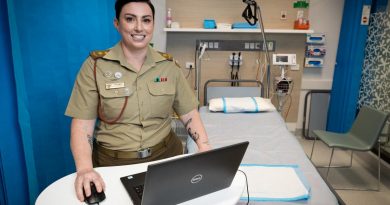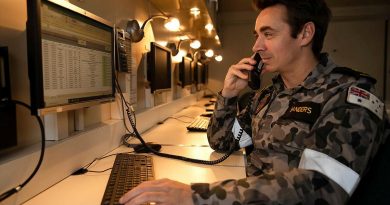Hats off to historic family find

A piece of family military history, uncovered during restoration works at a Brisbane railway station, has been returned to its rightful owners.
CAPTION: Former Navy paramedic Jamie Hodgess, left, and his nephew Army petroleum operator Warrant Officer Class Two Stuart Hodgess with the Navy hat that belonged to Jamie Hodgess’ father, Gus. Story by Captain Thomas Kaye . Photo by Lance Corporal Christopher Smith.
During the works at Shorncliffe train station, all construction was brought to a halt as a large collection of mid-20th century objects were discovered – including a long-lost sailor’s cap, dating from 1945-1950, unearthed during an archaeological dig.
Faded and tattered after being buried under the station master’s building, the cap was revealed to belong to Royal Australian Navy stoker Ernest “Gus” James Hodgess.
Senior Heritage Consultant Dr Xavier Carah, of Niche Environmental and Heritage, the company engaged for the heritage work, recognised instantly that it was a Royal Australian Navy hat, and found a way to make contact with the family.
“Often when you find personal items, it’s quite difficult to work out who it came from. Even with a name, it would be difficult to find the individual,” Dr Carah said.
“There were a few clues that helped narrow down the hunt for its rightful owner: World War II, some letters in a name and the deduction that it most likely belonged to a local on leave.
“A military historian reached out and said that they could help find the owner.”
The family was found, and on December 2, Queensland Rail presented the hat to Gus Hodgess’ son, former Navy paramedic Jamie Hodgess, who was accompanied by his nephew, Australian Army petroleum operator Warrant Officer Class Two Stuart Hodgess.
Warrant Officer Hodgess said his grandfather was a Korean war veteran.
“He served on the minesweeper HMAS Warrnambool,” Warrant Officer Hodgess said.
“It struck a mine in 1947 off the Great Barrier Reef near Cape Grenville, injuring some aboard with two dying of injuries later.
“My grandfather was able to swim back and forth, saving those on board.
“I’m very proud of him and the legacy I stand on.”
Before the presentation, the hat had been cleaned, stabilised and boxed by a conservator.
“This is a monumental event for not only my family, who are all ex-serving military personnel, it is also incredible to receive this in a special casing and have it back to where it belongs,” Warrant Officer Hodgess said.
Unable to attend the hat presentation because of border closures, Navy Warrant Officer Paul Bodensteiner, who followed in his uncle’s footsteps to join the Navy as a paramedic, said his grandfather was his inspiration to enlist.
“I was following in the footsteps of my grandfather and my uncle when I signed up. I was actually living with my grandfather when I joined the Navy in 1989,” Warrant Officer Bodensteiner said.
“I have always looked up to him, hearing stories about when he went to sea and when he went to Korea.
“He never told me much about the Warrnambool, but when I was on the new Warrnambool, he opened up a little more. He kept it close to his chest.
“He would always get me to wear his medals on Anzac Day, even from a young age, and it’s incredible to have another piece of his military history back with our family.”
It is not just the family that are happy to see the sailor’s hat find its way home. Dr Carah is also pleased with the outcome.
“It’s very rare to get this opportunity in cultural heritage management,” Dr Carah said.
“There’s a desire to repatriate items to the owners or decedents of the owners.
“To get the opportunity to return it to its owners is remarkable.
“We don’t often get that opportunity.”
Gus Hodgess is succeeded by three generations of Royal Australian Navy and Australian Army members, including members who are still currently serving.
As for the hat, it is with Jamie Hodgess, along with other memorabilia from Gus Hodgess’ Navy service.
.
.

.
.





